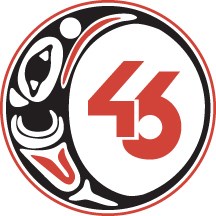Indigenous high school students on the Sunshine Coast are graduating at greater numbers than ever before. According to the Ministry of Education, the Indigenous completion rate was 79 per cent last school year, while the overall completion rate was 81 per cent.
School District No. 46 (SD46) superintendent Patrick Bocking raised the statistic during his report to the board on Feb. 14. “We have a remarkable team of educators on the Coast who weren’t comfortable with our Aboriginal students not achieving at the same rate as all of our students,” he said in an interview after the meeting.
Bocking said residential school led to intergenerational struggles that many Indigenous families are coping with. “Now we’re putting a lot of effort into trying to remedy those errors, those terrible mistakes.”
Approximately 600 students self identify as Indigenous or having Indigenous ancestry, and about 200 of them are from shíshálh Nation. There are 3,100 students in the district. “Lots of people make an assumption if we are talking about Aboriginal children it must be shíshálh Nation, and in fact the results are about all our students no matter what ancestry they come from,” said Kerry Mahlman, district principal, Aboriginal education.
Mahlman said the school district is “now seeing the results of work that began 16 to 18 years ago.” Historically, the Indigenous graduation rate on the Sunshine Coast has been above the provincial average, she said. The provincial average completion rate last year was 84 per cent, and the Indigenous average completion rate was 66 per cent.
The ministry provides enhanced funding to districts to support students with Indigenous ancestry. The SD46 Board of Education and Aboriginal Education Advisory Circle use that funding to provide a variety of cultural educational programs and services to those students.
Mahlman called the early 2000s a “pivotal moment.” District Aboriginal Pro-grams and Services began with Mahlman in 2000 and has grown to include seven educators and a handful of Aboriginal support workers, supported by a partnership between the shíshálh Nation, SD46 and CUPE.
Aboriginal Student Success Councillors work in each high school alongside the school-based councillor, and all high schools also have an Aboriginal Education Support teacher. “That kind of intensive support in high school … makes a big difference,” said Mahlman, who added the team works to build trust and relationships over time with each family.
She also attributes the students’ success to a special program she devised based on the lesser-known fact that the Ministry of Education recognizes that in some communities Indigenous people speak a distinct dialect of English.
“It is to be respected, it is a dialect. There is nothing deficient about it. But when young people go to school and they encounter an English more like your English teacher speaks … it’s different.”
She said she read the “fine print” about 12 years ago and was able to acquire funding for an opt-in English language development program. “I believe that particular program, among the many that we have, has made a significant difference for a lot of kids.” The district also teaches shíshálh language and other Indigenous language skills. “The kids walk away knowing, hey, basically, my world has three languages.”
The district is also in the process of fully implementing a mandatory First Peoples curriculum that requires educators to include Indigenous perspectives in all subjects. It is fully implemented from kindergarten to Grade 9, and implementation for Grades 10, 11 and 12 will begin next year. “It’s very much a process… It’s a big ship to turn around,” Bocking said.
Mahlman has already been working with her team to introduce cultural lessons that reflect the distinct Indigenous cultures at SD46. “If they know there are Anishinaabe kids in the school, they will learn creation stories,” said Mahlman. “Every cultural lesson, underneath it, there is actually going to be a language arts lesson or a math lesson.”



